CEDAR 5
1/475
There's no tags or description
Looks like no tags are added yet.
Name | Mastery | Learn | Test | Matching | Spaced |
|---|
No study sessions yet.
476 Terms
HOW IS A POLYPEPTIDE FORMED BY THE TRANSLATION OF mRNA?
mRNA attaches to ribosomes.
tRNA anticodons bind to complementary mRNA codons.
tRNA brings a specific amino acid.
Amino acids join by peptide bonds.
With the use of ATP.
tRNA released after amino acid joined to polypeptide.
The ribosome moves along the mRNA to form the polypeptide.
TRANSCRIPTION:
In the nucleus.
DNA helicase hydrolyses H bonds.
Only one stand acts as a template
Free flowing bases align by complementary base pairing.
Uracil pairs with adenine/replaces thyamine.
RNA polymerase catalyses formation of phosphodiester bonds between adjacent RNA molecules.
Introns removed by splicing.
Mature RNA with five prime end.
How To Catch Undercover Police Selling Monkeys
ANSWER FOR DNA, mRNA, AND tRNA?
HOW MANY POLYNUCLEOTIDE CHAINS?
WHICH IS THE LARGEST AND SMALLEST?
SHAPE?
WHAT IS THE PENTOSE SUGAR?
BASES?
WHERE IS TI FOUND?
IS IT CHEMICALLY STABLE?
DNA has double, others have single.
DNA largest and tRNA smallest.
Double helix, single helix, clover.
DNA has deoxyribose, others have ribose.
DNA has ATCG, others have AUGC.
DNA - nucleus, mRNA (manufactures in nucleolus) - found throughout cell, tRNA - cytoplasm.
DNA stable, mRNA least stable.
ADVANTAGE OF mRNA BEING BROKEN DOWN QUICKLY?
Allows the cell to regulate protein synthesis efficiently, so proteins are only produced when needed, preventing waste of resources.
WHY MUST DNA STAY IN THE NUCLEUS?
To stay away from chemical reactions.
WHAT DOS DNA CARRY?
The genetic code to allow the cell to make proteins.
WHAT IS THE PROTEOME?
Full range of proteins that the cell is able to produce.
WHAT IS THE ONLY DIFFERENCE BETWEEN DNA STRANDS?
Length.
Sequence of bases.
HOW MANY BASES ARE NEEDED TO CODE FOR AN AMINO ACID?
Three.
WHAT ARE THREE FEATURES OF THE GENETIC CODE?
The code is non-overlapping - each base would be a part of 3 triplets.
The code is degenerate - most amino acids are coded for by multiple triplets.
The code is universal - a given triplet will produce the same amino acid in all organisms.
HOW DO GENES CODE FOR PROTEINS?
They code for RNA.
WHAT IS rRNA?
Together with proteins, it forms ribosomes.
WHAT MAY mRNA CONSIST OF?
Thousands of nucleotides
in a single linear strand.
HOW IS mMRNA formed?
WHAT IS IT COMPLEMENTARY TO?
By the transcription of a gene in DNA in the nucleus.
Complementary to the DNA in its base sequence.
WHY AND WHERE IS mRNA EASILY BROKEN DOWN?
It has unpaired bases, so it is easily broken down in the cytoplasm.
It only needs to exist temporarily until the protein is manufactured.
HOW BIG IS tNRA?
WHAT IS IT?
Relatively small.
Around 80 nucleotides.
It is a single strand which folds back on itself.
WHICH BOND IS PRESENT IN A tRNA MOLECULE AND WHAT IS ITS PURPOSE?
WHAT DOES ONE END OF THE CHAIN ATTACH TO?
Hydrogen: Forms within complementary sections of the molecule - stabilises molecule.
One end of the chain attaches to an amino acid.
WHAT IS THE DIFFERENCE BETWEEN EACH TYPE OF tRNA?
WHAT IS AT THE BASE IF EVERY tRNA?
Each is able to carry a single specific amino acid.
Base has a sequence of three bases, known as the anticodon.
For each amino acid carried, there is a different sequence of bases on the anticodon.
CAN RNA LINK WITH DNA AND OTHER RNA?
Yes.
WHAT ARE THE TWO TYPES OF NON-CODING DNA?
WHERE IS IT FOUND?
Introns.
Multiple Repeats. (Called Variable Number Tandem Repeats).
Eukaryotic only.
T/F? MEMBERS OF THE SAME SPECIES HAVE THE SAME GENES.
True.
WHAT DOES IT MEAN TO BE A GENETICALLY DIVERSE POPULATION?
When a population has many different alleles for a particular gene.
WHAT IS THE GENE POOL?
The total information from all the genes and alleles of the breeding individuals in a population at a particular time.
Affected by birth, death, immigration, emigration, selection, and mutation.
WHAT DOES GENETIC DIVERSITY CREATE?
WHAT IS IT A RESULT OF?
It creates variation WITHIN a species.
It therefore allows natural selection.
RESULT OF:
Mutations.
Meiosis.
Random fusion of gametes.
WHEN DOES MEIOSIS OCCUR?
In the formation of gametes:
Ovum, sperm, ovule, pollen grain.
WHAT IS IT CALLED WHEN THERE IS VARIATION WITHIN A SPECIES?
Intraspecific variation.
KEY FEATURES OF MEIOSIS?
DNA replicates once, but there are two nuclear divisions.
Daughter cells have half the number of chromosomes - haploid number.
At fertilisation, diploid number is restored :: meiosis ensures that chromosome number stays constant from one generation to the next.
WHAT HAPPENS IN THE TWO PHASES OF MEIOSIS?
MEIOSIS I: Homologous pairs separate and the cells become haploid.
MEIOSIS II: Centromere breaks and chromatids separate.
WHAT IS CHROMOSOME DISJUNCTION?
Sometimes homologous chromosomes don’t separate and both chromosomes of a pair go into the same cell.
As a consequence, after fetilisation, zygotes can end up with an extra copy of a particular gene.
HOW DOES MEIOSIS LEAD TO INTRASPECIFIC VARIATION?
Meiosis provides opportunities of new combinations of alleles to occur in the gametes.
This leads to intraspecific variation in the offspring produced by fertilisation of the gametes.
WHAT IS INDEPENDANT SEGRAGTION?
First division, the pairs of homologous chromosomes pair up at the start.
When they line up along the equator, their orientation is completely random.
Subsequent separation of these pairs result in random shuffling of maternal and paternal chromosomes ::: different combinations of in the gametes formed.
2n.
CROSSING OVER:
When the homologous pairs come together at the start, chromatids of each pair become wrapped around each other at points called chiasmata.
Causes sections of each chromatid to break off and rejoin to the chromatid of the homologous partner. This is crossing over.
Alleles are exchanged between the maternal and paternal chromosomes - genetic recombination occurs.
When the chromosomes move apart and separate during meiosis, there may be new combinations of alleles on each chromosome, resulting in more variation in the gametes.
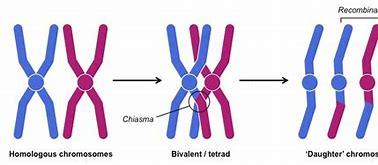
HOW CAN GENETIC VARIATION BE FURTHER INCREASED?
Further increased in sexual reproduction due to random recombination of maternal and paternal gametes during fertilisation,
WHAT IS A MUTATION?
WHEN DO THEY OCCUR?
Causes a change in the number/sequence of bases in an organism’s DNA.
Produces a change in characteristics which can be [assed onto cells.
Occurs during DNA replication.
Mutations occur with a predictable frequency that varies by species.
HOW CAN THE BASIC MUTATION RATE BE INCREASED?
Outside factors such as mutagenic agents.
Such as:
UV.
High ionising radiation - can disrupt the structure of DNA.
Chemicals.
WHAT CAN GENE MUTATIONS LEAD TO?
WHEN DO THEY OCCUR?
Production of non-functioning proteins.
Occur during DNA replication.
WHAT IS A GENE?
WHERE ARE THEY?
A section of DNA that codes for one polypeptide or functional RNA.
They occupy a fixed position on a CHROMOSOME called a locus.
GAMETIC?
In sex cells.
Inherited.
SOMATIC?
In body cells.
Accquired.
WHAT ARE THE TYPES OF MUTATION?
(PAPER ONE)
Additon/Deletion.
Substitution.
WHAT IS AN ADDITION/DELETION MUTATION?
WHAT DOES THIS CHANGE?
WHAT IS THE FANCY NAME?
Extra base added/removed.
Changes all subsequent triplets after the mutation, creating a completely new a.a sequence.
Called a frameshift mutation.
WHAT IS THE EFFECT OF A FRAMESHIFT MUTATION?
A base added/deleted at the start of a sequence could alter every triplet in the sequence.
A deleted base at the end as a smaller impact (but still an impact).
HOW MANY EFFECTS CAN A SUBSTITUTION HAVE?
WHAT ARE THEY?
EXPLAIN THEM?
Missense - can cause an a.a in a polypeptide to change, may no longer function properly.
Nonsence - change creates a stop codon, marking the end of translation —> production of polypeptide stopped prematurely, altered 3* structure —> non-functional.
Degenerate - same a.a coded for due to degenerate nature of genetic code.
WHY CAN SMALL ORGANISMS MEET ALL OF THEIR GAS EXCHANGE REQUIREMNETS THOUGH THEIR CSM ONLY?
They have large SA:V ratios.
WHY DO SMALLER ORGANISMS NEED TO RESPIRE FASTER?
They have large SA:V ratios so they lose heat faster.
They need a higher metabolic rate to respire faster to replace lost heat.
FICK’S LAW IN SMALL ORGANISMS:
[gradients] = continuous aerobic respiration.
Diffu pathway = Large SA:V.
SA = Small size (may have folds).
WHERE ARE THE GILLS?
WHAT ARE THEY THE FISH EQUIVALENT OF?
WHAT ARE THEY (colour)?
Gills are between the buccal cavity and operculum.
They are like ribs.
They are bright red due to blood flow.
WHAT DO THE LAMELLAE DO?
SA.
WHAT IS THE GAS EXCHANGE SURFACE IN FISH?
Lamellae (90* angles).
FICKS LAW OF FISH?
SA:
Each gill has many thin walled filaments.
Which have many lamellae.
Many blood capillaries.
PATH:
Capillary endothelium, lamellae, and epithelium are all thin.
CONC:
Counter current.
Continuous blood flow to capillaries ensures saturated oxygen is quickly removed.
WHAT IS THE COUNTER CURRENT SYSTEM?
Water flows in one direction and blood in the opposite, maintaining a steep [gradient].
Oxygen in water is always higher than blood.
(Oxygen gradient persists) Across the entire gill length.
WHY IS THE COUNTER CURRENT SYSTEM BETTER THAN THE PARALLEL FLOW SYSTEM?
Prevents equilibrium from being reached.
HOW DO FISH MAINTAIN A CONSTANT FLOW OF WATER OVER THEIR GILLS?
Mouth opens, operculum closes.
Floor of mouth lowered.
Volume :: pressure, water enters.
Mouth closes, operculum opens.
Floor of mouth raised.
Volume :: pressure, water pushed over gills.
WHY IS THE CONSTANT FLOW OF WATER NEEDED FOR EFFICIENT GAS EXCHANGE?
To allow the counter current process to occur.
HOW IS WATER LOSS MINIMISED ACROSS THE BODY SURFACE OF INSECTS?
The outermost layer is waxy and waterproof.
Chitin (rigid) is waterproof.
Hair on spiracles increase moisture.
Valves can close spiracles.
Small SA:V to area over which water can be lost.
WHY DO INSECTS NEED A SPECIALISED EXCHANGE SYSTEM?
Their tough exoskeleton prevents them from using their body surface for diffusion.
WHAT IS THE TRACHEAL SYSTEM?
A network of tracheae (air filled tubes) that open to the outside through spiracles (small holes in the exoskeleton).
WHY ARE THE SPIRACLES SPIRALLY?
They have rings of chitin.
These add support to prevent the collapse of the respiratory system.
:: prevents death.
DIAGRAM OF THE RESTING INSECT’S TRACHEAL SYSTEM?
Body wall is cuticle.
Cells have fluid.
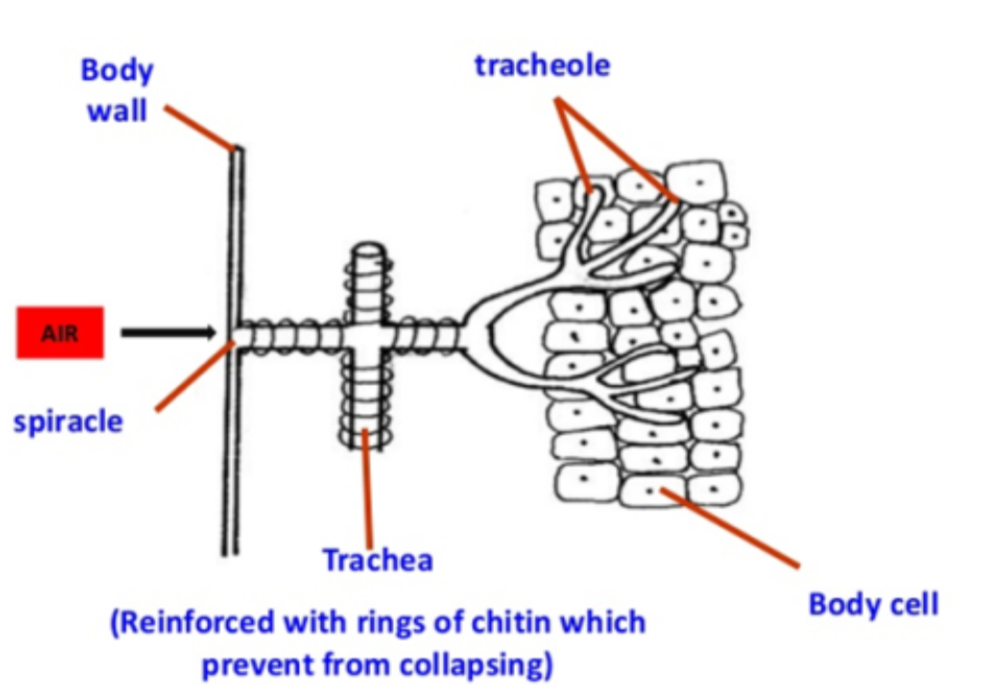
WHY IS THERE FLUID AS A PART OF THE TRACHEAL SYSTEM?
Diffusion occurs faster in gases.
As (soluble) lactic acid, Ψ.
H20 will move osmosis in.
Now O can diffuse in faster.
SA in contact with O.
WHAT IS THE SITE OF GAS EXCHANGE?
Tracheoles.
O diffuses directly into cells from them.
IS THERE VENTILLATION IN INACTIVE/SMALL INSECTS?
WHY?
No.
They rely on [gradient] created by respiration.
FICK’S LAW IN RESTING INSECTS?
SA:
Large no. trachea.
PATH:
Thin walled tracheoles.
Tracheoles in close proximity to cells.
CONC:
Cells respire.
FICK’S LAW IN ACTIVE INSECTS?
SA + PATH = Same.
CONC:
Abdominal pumping.
Remove fluid from the ends of tracheoles.
WHAT IS ABDOMINAL PUMPING?
Ventilation by contraction of the abdomen muscles.
Can force air in and out of the spiracles and trachea.
To maintain a greater airflow and maintain steeper [gradients].
FICK’S LAW IN PLANTS?
SA:
Spongy mesophyll layer cells are loosely packed, creating numerous air spaces.
PATH:
Spongy cells have thin cell walls.
Spongy cells directly in contact with air.
Many stomata.
Leaf is thin.
CONC:
Respiration.
Photosynthesis.
WHERE DO GASES ENTER AND LEAVE PLANTS?
Spongy mesophyll layer is in close contact with stomata (pores) where the gases leave and enter.
GAS EXHANGE SURFACE IN PLANTS?
Spongy mesophyll layer.
HOW DO PLANTS MINIMISE WATER LOSS?
Guard cells swell up to close stomata.
Waxy cuticle.
LEAF DIAGRAM?
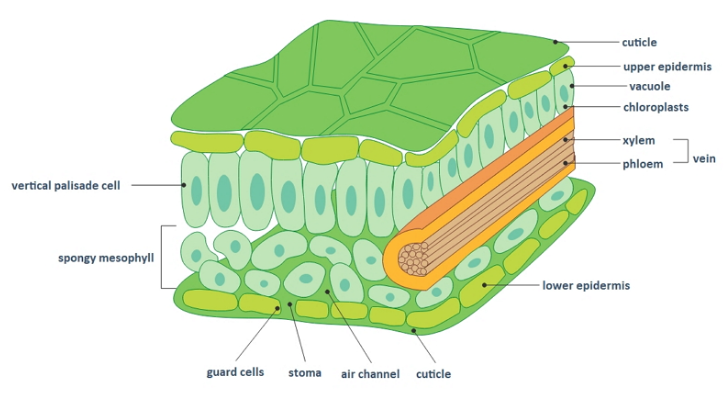
LUNG DIAGRAM?
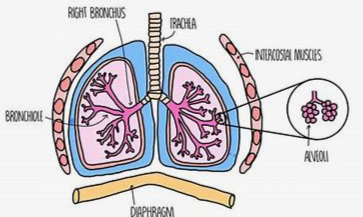
FUNCTION OF THE LUNGS?
To allow gaseous exchange between the air in the lungs and blood in the capillaries.
WHY IS GAS EXHANGE NEEDED?
Maintain constant supply of O to release E in the form of ATP for bodily function.
Remove CO2 otherwise it would lower pH dangerously (and denature enzymes).
WHY MUST LARGE VOLUMES OF GASES BE EXHANGED IN MAMMALS?
Warm blooded.
Small SA:V.
Large rate of respiration.
WHAT LINES THE AIRWAY + PURPOSE?
Mucus membranes.
Trap microorganisms and debris.
Keep airways clear.
WHAT DO MUCUS MEMBRANES CONTAIN +PURPOSE?
Goblet cells.
Secrete mucus.
Lined with ciliated epithelium.
ROLE OF CILLIA?
Beat regularly to move microorganisms and dust particles along with mucus.
PATHWAY OF AIR?
Air enters the airway through mouth/nose.
Air passes into trachea, then bronchi, then bronchioles.
Then alveoli.
DIAGRAME OF ALVEOLI?
FICK’S LAW OF ALVEOLI?
(Capillary wall also capillary endothelium.)
Moist - allows it to absorb gases.
Elastic tissue - maintains concentration (like a balloon).
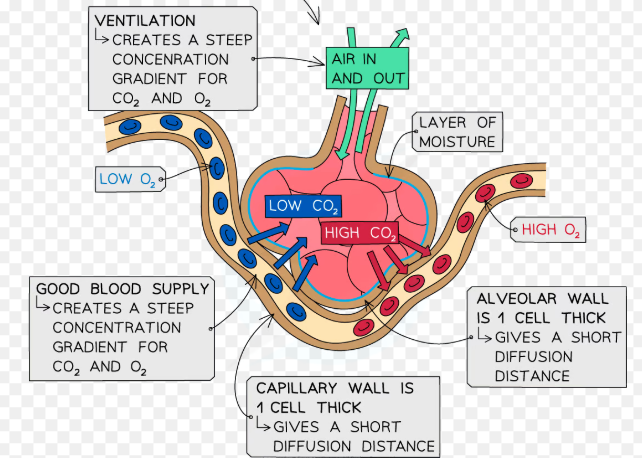
PATHWAY FROM ALVEOLI TO BLOOD?
Oxygen diffuses through the alveoli's epithelium and the blood capillaries' endothelium.
Here, it combines with haemoglobin in the RBC.
This maintains the [gradient].
Capillaries = one cell thick.
GAS EXHANGE AREA IN LUNGS?
Alveoli.
FICK’S LAW IN LUNGS?
SA:
Millions of alveoli.
Large SA of blood capillaries.
Lungs are compact.
THIN:
Only two layers of cells between air in alveoli and blood in capillaries:
Squamous epithelial of alveoli wall (thin epithelial cells).
Squamous epithelial of capillary wall.
Lungs are thin-walled.
CONC:
Capillaries provide good blood flow.
Highly elastic, maintains shape of alveoli and lungs, can expand and recoil during breathing.
Respiration.
Ventillation.
WHAT IS INSPIRATION?
IS IT PASSIVE?
Taking air into the thorax.
Passive.
QUANITITIES OF GASES EXHALED?
O = 16%
CO2 = 4%
N = 78%
WHY DOES AIR ENTER?
Air is drawn into the lungs when pressurethorax < pressureat.
Since the thorax is airtight, and the only opening to the outside is through the trachea.
DESCRIBE THE RELATIONSHIP BETWEEN VOLUME AND PRESSURE?
Inversely proportional.
WHAT DOES THE EXTERNAL INTERCOSTAL DO DURING INSPIRATION?
WHAT DOES THIS CAUSE THE DIAPRAGM TO DO?
Contracts.
D contracts and moves down.
VOLUME CHANGE DURING INSPIRATION?
Increases.
HOW DO THE INTERCOSTSTAL MUSCLES BRING ABOUT INSPIRATION?
They CONTRACT.
Diaphragm contacts and goes down + ribs pulled up and out.
:: Volumethorax :: Pressurelungs.
Pressureat > Pressurepulm :: air forced into lungs.
CHANGES IN EXPIRATION WHEN ITS ACTIVE?
Its active.
External relax :: internal contract (agonist).
:: ribcage pulled further down and in.
WHAT IS TIDAL VOLUME?
Volume of air breathed in/out of the lungs in a normal resting breath.
VENTILLATION RATE?
Number of breaths in/out per minute.
PULMONARY VENTILLATION + FORMULA?
Total volume of air that is moved into the lungs in one minute.
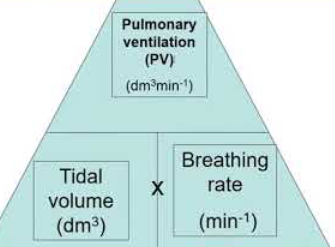
CAUSALLY LINKED?
One variable causes the other to occur.
WHAT IS DIGESTION?
The process by which larger molecules of food are hydrolysed into smaller, more soluble molecules that can be absorbed by the body.
HOW MANY WAYS DOES DIGESTION OCCUR?
Two In Humans:
PHYSICAL BREAKDOWN:
Large food particles are mechanically broken down into smaller ones by the action of the teeth and then by churning food in the stomach.
CHEMICAL BREAKDOWN:
Larger insoluble molecules are broken down into smaller soluble ones by the action of enzymes.
PURPOSE OF SALIVARY GLANDS?
Has enzymes (amylase) mixed with ions and water.
PURPOSE OF PANCREAS?
Produces pancreatic juice:
Mixture of enzymes (amylase, protease, and lipase).
Alkaline solution.
PURPOSE OF SMALL INTESTINE:
Digestion is completed here.
Uses pancreatic enzymes.
Uses enzymes produced by itself.
STARCH DIGESTION:
MOUTH (amylase) —> Hydrolyses starch to maltose.
SMALL INTESTINE (amylase and maltase) —> Continues hydrolysis and starch and completes hydrolyses of maltose. (Example of intracellular digestion).
Glucose molecules are either released into the lumen of the intestine and absorbed further along, or absorbed directly into epithelial cells.